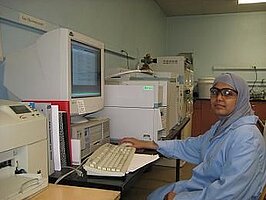Interactions between Microorganisms and Metal Nanoparticles: A New Approach for Groundwater Remediation

Rabiya Shabnam is a Master of Science student in Environmental Conservation Science program at North Dakota State University. She holds a Master of Science degree in Biochemistry from Periyar University, India, and Bachelor of Science degree in Biochemistry from Madras University, India. Her present research is focused on understanding the interactions between microorganisms and nanoparticles and how their relationship can be exploited for remediation of environmental contaminants of concern.
Email: rabiya.shabnam@ndsu.edu
Fellow: Rabiya Y Shabnam
Advisor: Achintya Bezbaruah, Ph.D., Assistant Professor, Department of Civil Engineering, North Dakota State University.
Co-Advisor: John M. McEvoy, Ph.D., Assistant Professor, Department of Veterinary and Microbiological Sciences, North Dakota State University.
Matching Support: North Dakota State University.
Degree Progress: M.S. in Environmental Conservation Science expected graduation in fall 2009.
Interactions between Microorganisms and Metal Nanoparticles: A New Approach for Groundwater Remediation
Nanoparticles are attractive for remediation of various contaminants because of their unique physico-chemical properties. Zero-valent iron (nZVI) is the most popular among the metal nanoparticles used in environmental remediation. Though nZVI have been extensively used for remediation, their efficacy has been evaluated excluding their possible interactions with environmental microorganisms. The present research is based on the hypothesis that symbiotic relationships develop between introduced nZVI and microorganisms. Nanoparticles can reduce a contaminant as the first step in the degradation process and microorganism can preferentially take over the process and reduce/oxidize the degradation byproduct(s) to benign end products or vice-versa. Reported work on nanoparticle and microorganism interactions is limited, specifically in the area of environmental engineering. The purpose of this study is to experimentally prove that microorganisms and nanoparticles develop symbiotic relationships or such relationships can be simulated under specific environmental conditions. The study will also explore possible uses of such relationships for enhanced environmental contaminant removal. Experiments will be conducted in ‘micro-reactors’ made of biopolymers (e.g., alginate). It is proposed to encapsulate nZVI and specific microorganisms in alginate microcapsules to study their interactions. The encapsulated microorganisms will be studied for their growth and viability. TCE will be used as the target contaminant in the initial studies. Other contaminants of concern will be used based on the results from the initial studies.
The present research is in continuation of the work proposed for the 2008 NDWRRI program.
Project Objectives:
The main objective of this study is to investigate the interactions between iron nanoparticles and microorganisms. The specific objectives include:
- Design, production and characterization of alginate microcapsules. Encapsulation of nZVI and specific microorganisms in calcium alginate microcapsules. (Completed)
- Study nZVI-microorganism interactions in terms of microbial growth and their behavioral changes. (In Progress)
- Conduct degradation studies for specific contaminants (e.g., TCE/phenols) (To be Completed)
Progress:
Alginate microcapsules were produced and characterization was done successfully. Diffusion studies and treatability studies have been completed. Progress has been made in studying the impact of nZVI on microorganism by monitoring the physiological activity of microorganisms over time. nZVI has shown no effect so far on E.coli and Pseudomonas putida F1 in our experiments. It is a positive outcome towards achieving our final goal of establishing a symbiotic relationship between nZVI and environmental microorganisms. Based on the work done so far a manuscript is under preparation to be submitted soon to a peer reviewed journal.
Research Outcomes:
Rabiya Shabnam, Senay Simsek, Jay M Thompson, Eakalak Khan, Achintya Bezbaruah. “Contaminant Diffusion and Degradation Studies with Alginate Encapsulated Iron Nanoparticles.” American Chemical Society Meeting March 2009, Salt Lake City, Utah. (Poster)
Rabiya Shabnam, Achintya Bezbaruah, Senay Simsek, Eakalak Khan, John McEvoy, Yildirim Bora Suzen. “Use of Biopolymer to Encapsulate Iron Nanoparticles: Diffusion and Treatability Studies.” International Environmental Nanotechnology Conference, Chicago, October 2008. (Poster)
Rabiya Shabnam, Achintya Bezbaruah, Senay Simsek, Eakalak Khan. “Biopolymer Encapsulated Metal Nanoparticles and Microorganisms for Environmental Remediation.” Presented at Annual Joint Student Environmental Conference, August 2008.NDSU. (Presentation)
Rabiya Shabnam, Achintya Bezbaruah, Senay Simsek, Eakalak Khan. “Encapsulation of Iron Nano Particles and Microorganisms with Alginate for Environmental Remediation.” AWWA Surface Water Conference, Moorhead, MN, April 2008 (Poster).
Significance:
Environmental nanoscience is one of the fastest emerging areas in the field of contaminant remediation. Successful encapsulation of iron nanoparticles and microorganisms in alginate capsules will lead to possible use of these ‘micro-reactors’ to degrade groundwater contaminant plumes when used in permeable reactive barriers. The results of this project will also be useful for the development of household treatment systems for drinking water. Most importantly this study will elucidate the nZVI-microorganism relationship that can be exploited further in other areas of science and technology.

Achintya Bezbaruah
Civil & Environmental Eng.
Office: Civil/Ind Eng 201G
Telephone: 701-231-7461
Email: a.bezbaruah@ndsu.edu

John McEvoy
AES Microbiological Sciences
Office: VanEs 132A
Telephone: 701-231-8530
Email: john.mcevoy@ndsu.edu


